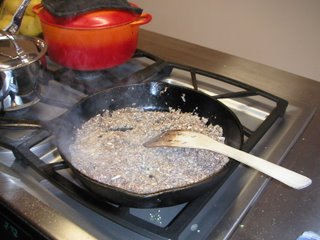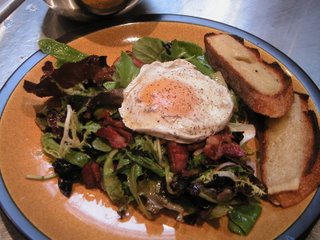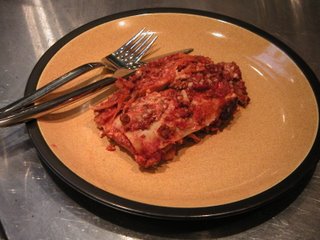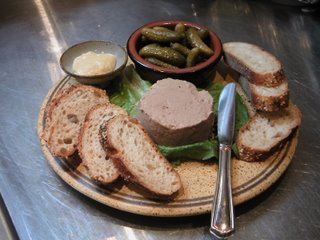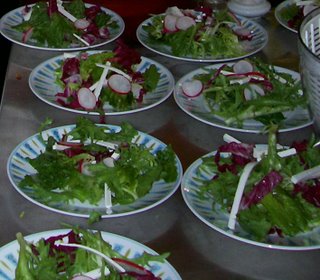Avocado and salmon domes
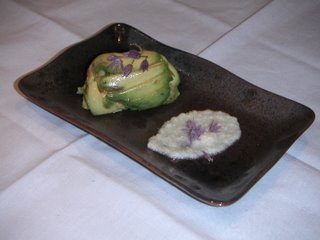 Hmmm, it is well past Mother's day, the VISA bill came (Mother's Day + Whole Foods = Ouch) and I still haven't posted my coulibiac that I made for dinner. And it’s a damn shame because I know how everyone is always looking for another coulibiac recipe.
Hmmm, it is well past Mother's day, the VISA bill came (Mother's Day + Whole Foods = Ouch) and I still haven't posted my coulibiac that I made for dinner. And it’s a damn shame because I know how everyone is always looking for another coulibiac recipe.
Speaking of too much of something, celebrity chefs get pretty tiring: Emerilware, Alton Brown's knives, Rachel Ray's plates, or what-have-you--it all gets pretty tiring. But the New York Times column "The Chef" has had many illuminating insights into how diverse chefs' minds work. Sometimes the emphasis is on creativity, others on technique, personal history, or unique ingredients.
Several years ago, Jack Bishop wrote this one with Wylie Dufresne, the chef of 71 Clinton Fresh Food in Manhattan.
This dish is somewhat mysterious when it comes to the table. A small dome of avocado scored with fine ridges, it looks almost like a small green sea creature or the model for a Frank Gehry building. There's no hint of what's contained within: a mound of bright pink fish cut into tiny cubes. But the dish has more than just a visual surprise and preppy colors going for it. The flavors are thoroughly unconventional, yet in perfect harmony.
And when the Copper River Salmon season opened, I thought this dish would be a great way to showcase the wonderful flavors of this fish (and the small portions would still be affordable).
It is a play on the ubiquitous tuna tartare and sushi. But it goes beyond the subtle textures and taste of sushi. The unctuous richness of the salmon and avocado is balanced by tart citrus, heat, and an unexpected crunch from diced pickles and sea salt.
Chives add that flavor that so uniquely pleases me with Japanese food, and always gives me pause as to why I don’t use them more often. Dufresne makes his own pickles, and suggests the pickled daikon radishes sold in Asian markets, but we went with the cornichons in the fridge, since I have never been able to stand the small of pickled daikon. I picked up kilos of fleur de sel in Paris a few years back as gifts for a friend who left me stranded at the airport (I kept the salt and ditched the friend.), so I prefer that and liberally sprinkle it around the mounds right before serving. Although he says any course salt will do, I would only stick with the airiest possible.
Because of his allergies Dale wasn’t too keen on the idea of horseradish, but he loved the fresh horseradish sauce so much that it has popped up at dinner at least once a week. (His brined pork chops with horseradish oil was very weeknight satisfying.)
As Dufresne says ‘The floral, spicy flavor of fresh horseradish brings all the elements on the plate together. It's worth spending five extra minutes to make the sauce.”
Marinated Salmon with Avocado (Adapted from Wylie Dufresne)
Time: 45 minutes
12 ounces salmon fillet with skin, pin bones and gray area removed (about 8 ounces when trimmed)
4 teaspoons minced fresh chives
4 teaspoons minced pickled radish or cornichons
2 teaspoons lime juice
2 teaspoons extra virgin olive oil
Table salt to taste
1/4 teaspoon Tabasco sauce, or to taste (I don’t care for Tabasco and prefer cayenne pepper)
2 medium ripe Haas avocados
Cracked black pepper to taste
Flaked or coarse sea salt for garnish
6 tablespoons creamy horseradish oil (see recipe below).
1. With a very sharp knife, cut salmon into thin slices, then chop it to the texture of coarsely ground meat. Place in bowl. Stir in chives, radish, lime juice, olive oil, table salt and Tabasco. Taste, and adjust seasonings.
2. Working with one avocado at a time, cut in half lengthwise. Twist to separate into 2 halves. Remove and discard pit. Cut off and discard 1/2 inch from top of each half. Carefully peel away and discard skin, trying not to gouge flesh with fingertips. Place halves pit side down. With tip of sharp knife, slice each half lengthwise as thin as possible, holding sides of avocado as you work so it keeps its shape. You should be able to cut each half into at least 12 slices.
3. Lay 18-by-12-inch sheet of plastic wrap flat on work surface. Slide side of knife under sliced avocado half. Transfer sliced avocado to plastic, turning pit side up. Press lightly with open hand to fan slices slightly. Season with table salt and pepper.
4. Spoon a quarter of the salmon mixture over center of avocado half. Lift opposite corners of wrap over fish, and repeat with 2 remaining corners. Grasp all 4 corners of wrap in one hand; with other, grasp avocado, and flip, twisting and pulling on corners of wrap to tighten it around underside of avocado. Twist avocado several times, pinching plastic tight under avocado and pushing avocado slices into original shape. Repeat with remaining avocado halves and salmon, forming each in its own piece of plastic. (Can be refrigerated 1 hour.)
5. Lay wrapped avocado on side, and slice off twisted portion of wrap just below avocado. Turn avocado with salmon filling facing up. Gently peel back wrap. Place small plate over avocado, and flip avocado onto plate so green side faces up. Repeat with other avocado halves. Sprinkle lightly with coarse salt. Drizzle horseradish oil around edges of plates, and serve immediately.
Yield: 4 first-course servings.
Creamy Horseradish Oil Adapted from Wylie Dufresne
Time: 5 minutes
3 ounces fresh horseradish, peeled and cut into chunks
1/2 teaspoon rice vinegar
Pinch salt
1/2 cup grape seed oil or other neutral oil.
1. Place horseradish, vinegar and salt in food processor, and grind, stopping to scrape down sides of bowl several times, until horseradish is quite fine, 1 to 2 minutes.
2. With processor motor running, add oil through feed tube in steady stream, and process just until mixture forms a creamy emulsion, about 1 minute. (Once mixture has sauce consistency, stop adding oil.) Adjust seasonings. Horseradish oil can be refrigerated in an airtight container for several days. Shake or whisk before using.
Yield: about 3/4 cup.
Note: You will need only about half this sauce for the marinated salmon wrapped in avocado. The rest can be served with grilled fish, steak or cold asparagus, or used on roast beef or lamb sandwiches.
The article continues with suggestions for variations:
-- Avocado and seafood have a natural affinity, and you can use this presentation technique with any number of fillings. The method remains the same: Prepare the seafood filling, slice the avocado, and stuff and shape individual portions. Here are a few suggestions:
Tuna tartare: To preserve the bright red color of fresh tuna, eliminate the lime juice, which would turn the fish white. Tuna is not as fatty as salmon, so the pickled radish will supply enough bite.
-- Scallop ceviche: Chop top-quality sea scallops a bit more coarsely than the salmon to give them a rougher texture. Marinate the chopped scallops in a little lemon juice, olive oil, minced red onion or shallot, salt and fresh herbs for about an hour. The slight firming caused by the acid makes the scallops a toothsome contrast to the creamy avocado. For an Asian flavor, cut down on the salt and add a splash of soy sauce.
-- Poached shrimp: Chop and lightly dress the shrimp. (I like the fruity flavor of an orange vinaigrette.) Add scallions and herbs to round out the filling.
-- Crab: Make a light salad of peekytoe or Jonah crabmeat. But don't use mayonnaise -- it will be too rich with the avocado. Instead, toss the crabmeat with a mustard vinaigrette, diced seeded tomatoes, shallots and fresh herbs.
